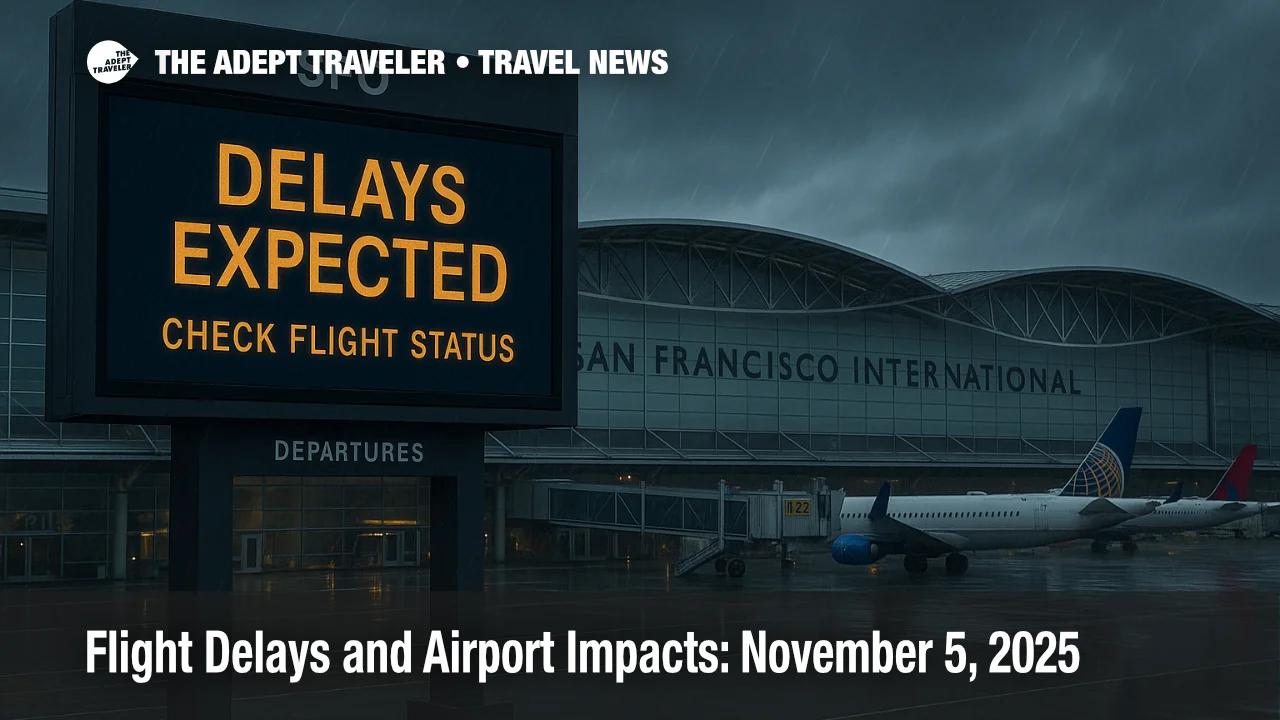Flight Delays and Airport Impacts: November 5, 2025

Key points
- ATCSCC issued an operations plan noting a wind-driven SFO ground delay program
- NAS Status flags possible ground stops or delays for SEA, BOS, JFK, and EWR
- Shutdown-driven staffing strain continues to elevate delay risk at major hubs
- NWS warns of strong Bay Area winds that can limit SFO arrival rates and cause holding
- Travelers should monitor airline alerts and allow extra time for tight connections
Impact
- Expect Rolling Programs
- SFO subject to wind-driven ground delay program today; SEA and BOS possible in peak banks
- Pad Connections
- Add 60-90 minutes when connecting through New York, Boston, or San Francisco
- Monitor Airline Messages
- Enable app notifications and watch for rebooking options or travel waivers
- Choose Earlier Flights
- Morning departures reduce exposure to pop-up delays during afternoon peak
- Consider Nearby Airports
- For Bay Area travel, compare OAK and SJC if schedules allow
The Federal Aviation Administration's Air Traffic Control System Command Center signaled weather and staffing-related constraints for Wednesday, November 5. The current operations plan notes a wind-driven ground delay program at San Francisco International Airport (SFO), while the National Airspace System dashboard indicates possible ground stops or delays later today at Seattle, Boston, JFK, and Newark. Travelers connecting through these hubs should expect sporadic holds and lengthened taxi-out times, especially in the late morning through evening banks.
San Francisco, winds and rate cuts
Strong onshore winds are the primary driver for SFO's constraints. The ATCSCC operations plan explicitly calls out a ground delay program for SFO due to wind, which reduces the airport's arrival rate and pushes inbound flights into en-route or gate holds. The National Weather Service Bay Area forecast discussion highlights wind, rain, and isolated thunderstorms today, with peak gusts widely strong enough to force conservative runway use and spacing. Local reporting overnight also noted significant SFO delays as winds ramped up.
Northeast and Pacific Northwest watch list
While not all programs are certain, the FAA's live NAS Status indicates potential ground stops or delay programs after the morning push for Seattle and Boston, and risk flags for JFK and Newark given ongoing staffing limitations. Even short programs can create long tails on mid-day and evening connections, so flyers should build extra buffer time and consider earlier departures where feasible.
Shutdown strain remains a systemic factor
Controller staffing shortages have compounded weather impacts over the last week, producing temporary ground stops and extended ground delay programs at busy facilities including LaGuardia, Newark, Dallas, and Austin. Federal officials warned that continued shutdown pressure could force more aggressive traffic management, including reduced arrival rates and, if required for safety, limited airspace availability in specific regions. Expect the system to prioritize safety by slowing flows when facilities are thinly staffed.
What to do if you fly today
If you are booked to or through SFO, SEA, BOS, JFK, or EWR, use your airline's app to confirm your flight's "EDCT" time, which is the slot assigned during a ground delay program. Rebook to earlier flights if you have a tight connection, and avoid last-bank arrivals into New York or Boston when storms or staffing advisories appear. For the Bay Area, compare Oakland and San Jose schedules if your plans are flexible, since localized wind at SFO can leave nearby airports less affected. Keep an eye on gate pushes and taxi-out estimates, which can balloon during pop-up departure metering.
Background: How ground delay programs work
When weather or staffing lowers an airport's arrival rate, the FAA issues a ground delay program to meter departures from origin airports. Flights receive an Expect Departure Clearance Time, spacing arrivals to match the reduced rate. This prevents airborne holding, but it shifts delay earlier in the journey. If conditions improve, programs are revised or canceled; if they worsen, a ground stop can temporarily halt releases until the airport can safely accept arrivals again.
Final thoughts
Flight delays and airport impacts on November 5 center on SFO's wind-driven constraints, with watch areas in the Northeast and Pacific Northwest. The combination of adverse weather and staffing pressure argues for conservative planning today. Build buffer time, monitor your airline's messages, and move to earlier departures when you can.
